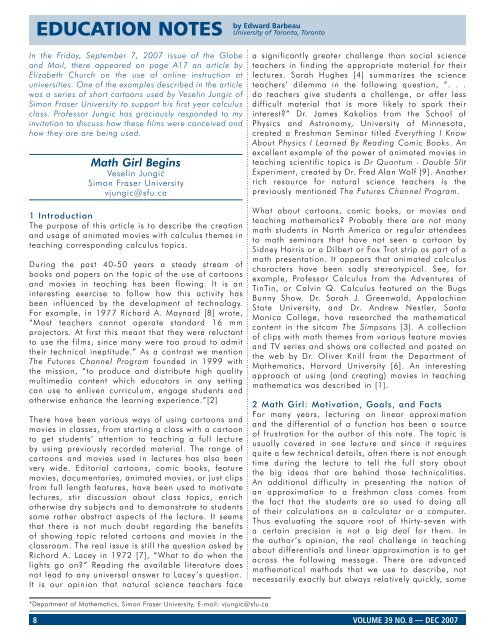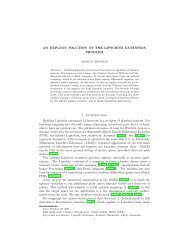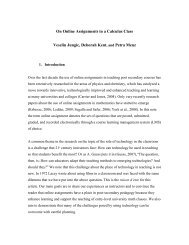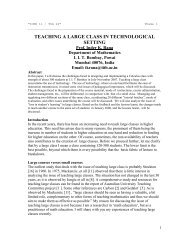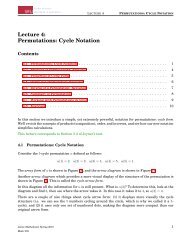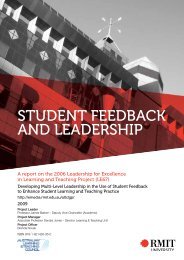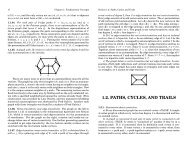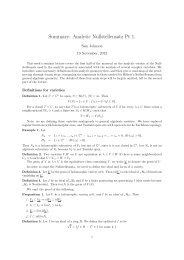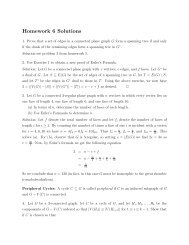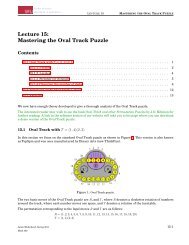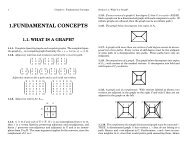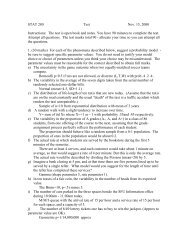Math Girl Begins - People.stat.sfu.ca - Simon Fraser University
Math Girl Begins - People.stat.sfu.ca - Simon Fraser University
Math Girl Begins - People.stat.sfu.ca - Simon Fraser University
You also want an ePaper? Increase the reach of your titles
YUMPU automatically turns print PDFs into web optimized ePapers that Google loves.
EDUCATION NOTES<br />
by Edward Barbeau<br />
<strong>University</strong> of Toronto, Toronto<br />
In the Friday, September 7, 2007 issue of the Globe<br />
and Mail, there appeared on page A17 an article by<br />
Elizabeth Church on the use of online instruction at<br />
universities. One of the examples described in the article<br />
was a series of short <strong>ca</strong>rtoons used by Veselin Jungic of<br />
<strong>Simon</strong> <strong>Fraser</strong> <strong>University</strong> to support his first year <strong>ca</strong>lculus<br />
class. Professor Jungic has graciously responded to my<br />
invitation to discuss how these films were conceived and<br />
how they are are being used.<br />
<strong>Math</strong> <strong>Girl</strong> <strong>Begins</strong><br />
Veselin Jungić<br />
<strong>Simon</strong> <strong>Fraser</strong> <strong>University</strong><br />
vjungic@<strong>sfu</strong>.<strong>ca</strong><br />
1 Introduction<br />
The purpose of this article is to describe the creation<br />
and usage of animated movies with <strong>ca</strong>lculus themes in<br />
teaching corresponding <strong>ca</strong>lculus topics.<br />
During the past 40-50 years a steady stream of<br />
books and papers on the topic of the use of <strong>ca</strong>rtoons<br />
and movies in teaching has been flowing. It is an<br />
interesting exercise to follow how this activity has<br />
been influenced by the development of technology.<br />
For example, in 1977 Richard A. Maynard [8] wrote,<br />
“Most teachers <strong>ca</strong>nnot operate standard 16 mm<br />
projectors. At first this meant that they were reluctant<br />
to use the films, since many were too proud to admit<br />
their techni<strong>ca</strong>l ineptitude.” As a contrast we mention<br />
The Futures Channel Program founded in 1999 with<br />
the mission, “to produce and distribute high quality<br />
multimedia content which edu<strong>ca</strong>tors in any setting<br />
<strong>ca</strong>n use to enliven curriculum, engage students and<br />
otherwise enhance the learning experience.”[2]<br />
There have been various ways of using <strong>ca</strong>rtoons and<br />
movies in classes, from starting a class with a <strong>ca</strong>rtoon<br />
to get students’ attention to teaching a full lecture<br />
by using previously recorded material. The range of<br />
<strong>ca</strong>rtoons and movies used in lectures has also been<br />
very wide. Editorial <strong>ca</strong>rtoons, comic books, feature<br />
movies, documentaries, animated movies, or just clips<br />
from full length features, have been used to motivate<br />
lectures, stir discussion about class topics, enrich<br />
otherwise dry subjects and to demonstrate to students<br />
some rather abstract aspects of the lecture. It seems<br />
that there is not much doubt regarding the benefits<br />
of showing topic related <strong>ca</strong>rtoons and movies in the<br />
classroom. The real issue is still the question asked by<br />
Richard A. Lacey in 1972 [7], “What to do when the<br />
lights go on?” Reading the available literature does<br />
not lead to any universal answer to Lacey ’s question.<br />
It is our opinion that natural science teachers face<br />
a signifi<strong>ca</strong>ntly greater challenge than social science<br />
teachers in finding the appropriate material for their<br />
lectures. Sarah Hughes [4] summarizes the science<br />
teachers’ dilemma in the following question, “. . .<br />
do teachers give students a challenge, or offer less<br />
difficult material that is more likely to spark their<br />
interest?” Dr. James Kakalios from the School of<br />
Physics and Astronomy, <strong>University</strong> of Minnesota,<br />
created a Freshman Seminar titled Everything I Know<br />
About Physics I Learned By Reading Comic Books. An<br />
excellent example of the power of animated movies in<br />
teaching scientific topics is Dr Quantum - Double Slit<br />
Experiment, created by Dr. Fred Alan Wolf [9]. Another<br />
rich resource for natural science teachers is the<br />
previously mentioned The Futures Channel Program.<br />
What about <strong>ca</strong>rtoons, comic books, or movies and<br />
teaching mathematics? Probably there are not many<br />
math students in North Ameri<strong>ca</strong> or regular attendees<br />
to math seminars that have not seen a <strong>ca</strong>rtoon by<br />
Sidney Harris or a Dilbert or Fox Trot strip as part of a<br />
math presentation. It appears that animated <strong>ca</strong>lculus<br />
characters have been sadly stereotypi<strong>ca</strong>l. See, for<br />
example, Professor Calculus from the Adventures of<br />
TinTin, or Calvin Q. Calculus featured on the Bugs<br />
Bunny Show. Dr. Sarah J. Greenwald, Appalachian<br />
State <strong>University</strong>, and Dr. Andrew Nestler, Santa<br />
Moni<strong>ca</strong> College, have researched the mathemati<strong>ca</strong>l<br />
content in the sitcom The Simpsons [3]. A collection<br />
of clips with math themes from various feature movies<br />
and TV series and shows are collected and posted on<br />
the web by Dr. Oliver Knill from the Department of<br />
<strong>Math</strong>ematics, Harvard <strong>University</strong> [6]. An interesting<br />
approach at using (and creating) movies in teaching<br />
mathematics was described in [1].<br />
2 <strong>Math</strong> <strong>Girl</strong>: Motivation, Goals, and Facts<br />
For many years, lecturing on linear approximation<br />
and the differential of a function has been a source<br />
of frustration for the author of this note. The topic is<br />
usually covered in one lecture and since it requires<br />
quite a few techni<strong>ca</strong>l details, often there is not enough<br />
time during the lecture to tell the full story about<br />
the big ideas that are behind those techni<strong>ca</strong>lities.<br />
An additional difficulty in presenting the notion of<br />
an approximation to a freshman class comes from<br />
the fact that the students are so used to doing all<br />
of their <strong>ca</strong>lculations on a <strong>ca</strong>lculator or a computer.<br />
Thus evaluating the square root of thirty-seven with<br />
a certain precision is not a big deal for them. In<br />
the author’s opinion, the real challenge in teaching<br />
about differentials and linear approximation is to get<br />
across the following message. There are advanced<br />
mathemati<strong>ca</strong>l methods that we use to describe, not<br />
necessarily exactly but always relatively quickly, some<br />
*Department of <strong>Math</strong>ematics, <strong>Simon</strong> <strong>Fraser</strong> <strong>University</strong>, E-mail: vjungic@<strong>sfu</strong>.<strong>ca</strong><br />
8 VOLUME 39 NO. 8 — DEC 2007
EDUCATION NOTES<br />
continued<br />
compli<strong>ca</strong>ted phenomena and often we are able to get<br />
information about the degree of our imprecision. In<br />
<strong>Math</strong> <strong>Girl</strong>’s words, “Close enough is sometimes good<br />
enough.”<br />
Motivated by Dr. Jonathan Borwein’s remark that<br />
“in mathematics sometimes it is easier to see than<br />
to say ” in early 2004 the author met with Mr. Jesai<br />
Jayhmes, an actor and director, to discuss the options<br />
of creating an animated video. The original idea<br />
was to make a film in which the small image of a<br />
math instructor would be seen traveling along the<br />
graph of a function and one of its tangent lines.<br />
While doing so the instructor would demonstrate the<br />
principles and properties of the linear approximation<br />
and differentials. This proposal was deemed to be too<br />
expensive and the notion of a <strong>ca</strong>rtoon was brought<br />
up. Next, together with Mr. Lou Crockett, an artist,<br />
animator, and designer, Mr. Jayhmes and the author<br />
<strong>ca</strong>me up with the idea of creating a superhero, who<br />
would personify all mathemati<strong>ca</strong>l knowledge. The<br />
choice of a female character was easy. On a midterm<br />
in a 500 student strong <strong>ca</strong>lculus class, taught by the<br />
author of this note in 2002, only one student got 100<br />
per cent and, when the student was asked to stand<br />
up, a tiny young woman reluctantly rose in the large<br />
lecture hall. <strong>Math</strong> <strong>Girl</strong> was born.<br />
Three <strong>ca</strong>rtoon movies, Differentials Attract, Zero!’s<br />
Dis-Continuity, and Rationalize This!, about the<br />
adventures of <strong>Math</strong> <strong>Girl</strong>, a super heroine who uses<br />
her super knowledge of mathematics to protect<br />
the citizens of Calculopolis from the evil plots of a<br />
villain <strong>ca</strong>lled Zero! have been created so far. Each<br />
episode is a short story in which the plot is based<br />
on a particular math object and its properties. The<br />
episodes are independent of each other. The ambition<br />
of the authors of the shorts was to accomplish two<br />
goals: to use a pop-culture medium to give a new<br />
view (or use) of the well known mathemati<strong>ca</strong>l objects<br />
and at the same time to enrich the medium itself by<br />
introducing mathematics as a subject. <strong>Math</strong>ematics<br />
in the movies is strict but not detailed enough to be<br />
self-contained. In following with the medium’s clichés,<br />
the stories are based on the fight between good and<br />
evil; where good is a synonym for mathemati<strong>ca</strong>l<br />
knowledge. In her civilian clothes <strong>Math</strong> <strong>Girl</strong> is an<br />
ordinary student, a smart girl who wears glasses.<br />
When she takes her superpower alter ego, thanks<br />
to her superb understanding of mathematics, <strong>Math</strong><br />
<strong>Girl</strong> becomes a super heroine. Other characters<br />
introduced in the <strong>Math</strong> <strong>Girl</strong> movies are <strong>Math</strong> <strong>Girl</strong>’s<br />
sidekick Pat Thagoras, a young man who admires<br />
<strong>Math</strong> <strong>Girl</strong>; professorial Big <strong>Math</strong>, the mayor of<br />
Calculopolis; and Zero!, the evil character whose<br />
goal is to rule Calculopolis by exploiting people’s<br />
ignorance of mathematics. Characters’ appearances<br />
were inspired by Manga 1 images. The movies might<br />
be seen as a benign parody of both the pop medium<br />
and scholarship and this makes the audience often<br />
react with laughter at scenes. It is a fact that even<br />
planning to step outside of the standard delivery<br />
of an edu<strong>ca</strong>tional topic requires the involvement of<br />
people with various skills and expertise. Also, in its<br />
initial phase a proposal of creating a new type of an<br />
edu<strong>ca</strong>tional resource must be general and flexible<br />
enough to accommodate a range of constraints<br />
that may emerge during the process. There are two<br />
necessary conditions for moving the project forward.<br />
The first is to form a team of people willing to put their<br />
talents together towards making a joint product. The<br />
other is to secure enough funds to complete the task<br />
in a satisfactory manner. To meet those two conditions<br />
in a<strong>ca</strong>demia is not a quick and simple procedure 2 .<br />
The biggest challenge for the authors of the <strong>Math</strong> <strong>Girl</strong><br />
movies was to find the balance between the necessary<br />
mathematics and the flow of the story. The problem<br />
could be described as: what to show, what to say,<br />
and how to wrap everything up so that the viewer<br />
sees beyond three-fingered human-like images. In<br />
addition, the intent was to demonstrate to the viewer<br />
a range of properties of the particular mathemati<strong>ca</strong>l<br />
phenomenon. The general approach that the authors<br />
had chosen was to keep all of the mathematics as<br />
simple as possible. This, for example, meant to repeat<br />
a <strong>ca</strong>tchy phrase that gave the idea of approximation<br />
(“Close enough is sometimes good enough”), to loosen<br />
mathemati<strong>ca</strong>l language whenever it was possible (“The<br />
differential is very small, so I <strong>ca</strong>n easily reach you,<br />
Pat”), to materialize mathemati<strong>ca</strong>l objects (”Square<br />
Root Mountain”, “Linear Approximator”, “Sine T Over<br />
T Roller Coaster”, “Epsilon - Delta Device”) etc.<br />
During the process some mathemati<strong>ca</strong>l details were<br />
omitted. For example, a graph showing a differentiable<br />
function, its tangent line, together with the increments<br />
of independent and dependent variables for both the<br />
function and the tangent line, and the differential was<br />
part of the script for the episode <strong>ca</strong>lled Differentials<br />
Attract. After a long discussion it was decided to omit<br />
the graph from the <strong>ca</strong>rtoon. The reason was that the<br />
information contained in it could not be absorbed in<br />
a few seconds, the time that the graph would appear<br />
on the screen.<br />
1 For more about Manga, The Art to Anime, please see http://www.manga.com/<br />
2 The funds for the <strong>Math</strong> <strong>Girl</strong> movies were obtained from the following sources: the Department of <strong>Math</strong>ematics at <strong>Simon</strong> <strong>Fraser</strong> <strong>University</strong> (SFU),<br />
the Faculty of Applied Science at SFU, the Faculty of Science at SFU, the Interdisciplinary Research in <strong>Math</strong>ematics and Computational Sciences<br />
Centre (IRMACS) at SFU, the Learning and Instructional Development Centre (LIDC) at SFU, and an NSERC PromoScience Grant.<br />
VOLUME 39 NO. 8 — DEC 2007 9
EDUCATION NOTES<br />
continued<br />
3 <strong>Math</strong> <strong>Girl</strong>: The Lights Are On<br />
It seems that there is no question that the <strong>Math</strong> <strong>Girl</strong><br />
movies are entertaining for a student audience. In our<br />
view it is not realistic to expect that a 50-minute long<br />
lecture <strong>ca</strong>n be compressed into a 5-minute <strong>ca</strong>rtoon.<br />
The math involved is much too quick for students<br />
to be able to fully understand the concept being<br />
communi<strong>ca</strong>ted from the first viewing. Thus, the idea<br />
is to utilize the <strong>Math</strong> <strong>Girl</strong> movies as a complement to<br />
the lecture.<br />
The way that the <strong>ca</strong>rtoons have been used in the<br />
class is to show the short at the beginning and at the<br />
end of the lecture. During the remaining 40 minutes,<br />
the instructor covers the topic in a standard manner.<br />
The purpose of showing the movie at the beginning<br />
of the lecture is to give a motivation for the topic<br />
and to introduce the basic terms related to it. Also,<br />
stories of the first two <strong>Math</strong> <strong>Girl</strong> adventures are<br />
based on standard examples; therefore the movies<br />
contain actual links with the particular lectures. It<br />
has been noticed that when students view <strong>Math</strong> <strong>Girl</strong><br />
just before the lecture, their participation increases<br />
and their general mood is more upbeat and positive<br />
than usual. Survey results show that these animated<br />
movies have resulted in positive responses from the<br />
majority of students, particularly female students.<br />
Another effect that the pop medium part of the <strong>Math</strong><br />
<strong>Girl</strong> movies has on the young audience is that it demystifies<br />
the lecture topic. The reason the <strong>ca</strong>rtoon is<br />
shown again at the end of the class is to demonstrate<br />
to the students how much better they understand the<br />
mathematics in the <strong>ca</strong>rtoon after the lecture. This is<br />
also an opportunity for the instructor to underline the<br />
main points in the lecture.<br />
The author of this note hopes that a lecture constructed<br />
in the described style would excite students’ intellectual<br />
curiosity and motivate them to look at mathematics not<br />
just as a set of techni<strong>ca</strong>lities and appli<strong>ca</strong>tions, but also<br />
as a playground where human imagination interacts<br />
with reality. In the author’s opinion that memorable<br />
moment of laughter in a <strong>ca</strong>lculus classroom justifies<br />
the time and effort of a dozen people working for a<br />
few months to create one <strong>Math</strong> <strong>Girl</strong> episode.<br />
The following email message by a student illustrates<br />
the serious side of the effect of the first <strong>Math</strong> <strong>Girl</strong><br />
episode, “Until recently, I have heard all my life<br />
in mathematics that everything must be exact and<br />
precise. So why is it now that we are told, ‘Close<br />
enough is good enough?’” [5]<br />
and the Faculty of Applied Science at <strong>Simon</strong> <strong>Fraser</strong><br />
<strong>University</strong> have used the first two episodes for the<br />
purpose of recruiting. As well, the <strong>ca</strong>rtoons have<br />
been used to promote mathematics among young<br />
people in general. An example is the projection of the<br />
first episode during the Canada Wide Science Fair<br />
at Science World in Vancouver, B.C., in May 2005.<br />
Thanks to YouTube, tens of thousands of people have<br />
been able to view the first two episodes. <strong>Math</strong> <strong>Girl</strong> has<br />
also used her powers to put a graph of the function<br />
t<br />
f( t) = sin on the front page of The Globe and Mail<br />
t<br />
– a first in the history of Canadian journalism. It has<br />
become clear that in front of the general public, <strong>Math</strong><br />
<strong>Girl</strong> has been judged not only based on her own<br />
merits, but also as a piece of pop culture.<br />
References<br />
[1] Tim Fahlberg, Linda Fahlberg-Stojanovska and<br />
Rev. Graeme MacNeil, Whiteboard math movies,<br />
Teaching <strong>Math</strong>ematics and its Appli<strong>ca</strong>tions 26(1)<br />
(2007) 17-22.<br />
[2] The Futures Channel Program,<br />
http://www.thefutureschannel.com<br />
[3] Sarah J. Greenwald and Andrew Nestler: Engaging<br />
Students with Signifi<strong>ca</strong>nt <strong>Math</strong>emati<strong>ca</strong>l Content From<br />
The Simpsons, PRIMUS, Vol XIV, Num 1, March, 2004,<br />
pp. 29-39.<br />
[4] Sarah Hughes, Comic Book Science in Classroom,<br />
NPR Morning Edition, April 8, 2005.<br />
[5] Josh Weissbock, Private Communi<strong>ca</strong>tion, 2006.<br />
[6] Oliver Knill, Personal website,<br />
http://www.math.harvard.edu/10knill/mathmovies/<br />
index.html.<br />
[7] Richard A. Lacey, Seeing With Feeling, Film in<br />
Classroom, W. B. Saunders Company, 1972.<br />
[8] Richard A. Maynard, Classroom Cinema, Teachers<br />
College, Columbia <strong>University</strong> New York, London,<br />
1977.<br />
[9] Fred Alan Wolf, Dr Quantum - Double Slit<br />
Experiment,<br />
http://www.youtube.com/watch?v=DfPeprQ7oGc<br />
Since the first episode was released, <strong>Math</strong> <strong>Girl</strong> has<br />
taken on a life of her own. Apart from the classroom,<br />
the student recruiters from the Faculty of Science<br />
10 VOLUME 39 NO. 8 — DEC 2007


